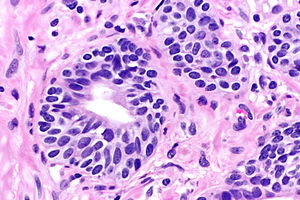Difference between revisions of "Basal cell hyperplasia of the prostate"
Jump to navigation
Jump to search
| (2 intermediate revisions by the same user not shown) | |||
| Line 1: | Line 1: | ||
{{ Infobox diagnosis | |||
| Name = {{PAGENAME}} | |||
| Image = Basal cell hyperplasia of prostate - very high mag.jpg | |||
| Width = | |||
| Caption = Basal cell hyperplasia of prostate. [[H&E stain]]. (WC) | |||
| Synonyms = | |||
| Micro = low power gland architecture near normal, glands usually ''not'' as small as cancer, usu. lack nuclear hyperchromasia, two cell populations (as in normal prostate glands), basal cells may have [[nucleoli]] | |||
| Subtypes = | |||
| LMDDx = urothelial metaplasia, [[prostate carcinoma]] | |||
| Stains = | |||
| IHC = basal presents (p63 +ve, CK34betaE12 +ve) | |||
| EM = | |||
| Molecular = | |||
| IF = | |||
| Gross = | |||
| Grossing = | |||
| Staging = | |||
| Site = [[prostate gland]] | |||
| Assdx = | |||
| Syndromes = | |||
| Clinicalhx = | |||
| Signs = none | |||
| Symptoms = none | |||
| Prevalence = common | |||
| Bloodwork = | |||
| Rads = none | |||
| Endoscopy = | |||
| Prognosis = benign | |||
| Other = incidental microscopic finding | |||
| ClinDDx = | |||
| Tx = none | |||
}} | |||
'''Basal cell hyperplasia of the prostate''', also known as '''basal cell hyperplasia''', is a benign change of the [[prostate gland]] that may be misdiagnosed as [[prostate carcinoma]]. | '''Basal cell hyperplasia of the prostate''', also known as '''basal cell hyperplasia''', is a benign change of the [[prostate gland]] that may be misdiagnosed as [[prostate carcinoma]]. | ||
| Line 11: | Line 43: | ||
*No nuclear hyperchromasia. | *No nuclear hyperchromasia. | ||
*Two cell populations (as in normal prostate glands). | *Two cell populations (as in normal prostate glands). | ||
*Basal cells may have nucleoli. | *Basal cells may have [[nucleoli]]. | ||
DDx: | DDx: | ||
Latest revision as of 14:16, 30 June 2016
| Basal cell hyperplasia of the prostate | |
|---|---|
| Diagnosis in short | |
 Basal cell hyperplasia of prostate. H&E stain. (WC) | |
|
| |
| LM | low power gland architecture near normal, glands usually not as small as cancer, usu. lack nuclear hyperchromasia, two cell populations (as in normal prostate glands), basal cells may have nucleoli |
| LM DDx | urothelial metaplasia, prostate carcinoma |
| IHC | basal presents (p63 +ve, CK34betaE12 +ve) |
| Site | prostate gland |
|
| |
| Signs | none |
| Symptoms | none |
| Prevalence | common |
| Radiology | none |
| Prognosis | benign |
| Other | incidental microscopic finding |
| Treatment | none |
Basal cell hyperplasia of the prostate, also known as basal cell hyperplasia, is a benign change of the prostate gland that may be misdiagnosed as prostate carcinoma.
General
- Benign lesion that can be misdiagnosed as cancer.[1]
Microscopic
Features:[2]
- Low power gland architecture near normal.[3][4]
- Glands not as small as cancer.
- Folds in gland lumina.
- No nuclear hyperchromasia.
- Two cell populations (as in normal prostate glands).
- Basal cells may have nucleoli.
DDx:
- High-grade prostatic intraepithelial neoplasia - has nuclear hyperchromasia, architecture usually different (micropapillary, tufted, cribriform or flat).
- Prostatic adenocarcinoma.
- Adenoid cystic/basal cell carcinoma of the prostate - for the adenoid cystic-like pattern of BCH.[5]
- Urothelial metaplasia of the prostate - larger cells, cell borders seen.
Images
www
Sign out
- Usually not reported.
See also
References
- ↑ Cleary, KR.; Choi, HY.; Ayala, AG. (Dec 1983). "Basal cell hyperplasia of the prostate.". Am J Clin Pathol 80 (6): 850-4. PMID 6195916.
- ↑ URL: http://pathologyoutlines.com/prostate.html#bch. Accessed on: 28 June 2010.
- ↑ URL: http://www.nature.com/modpathol/journal/v16/n6/fig_tab/3880810f1.html. Accessed on: 28 June 2010.
- ↑ URL: http://www.nature.com/modpathol/journal/v16/n6/fig_tab/3880810f2.html. Accessed on: 28 June 2010.
- ↑ McKenney, JK.; Amin, MB.; Srigley, JR.; Jimenez, RE.; Ro, JY.; Grignon, DJ.; Young, RH. (Oct 2004). "Basal cell proliferations of the prostate other than usual basal cell hyperplasia: a clinicopathologic study of 23 cases, including four carcinomas, with a proposed classification.". Am J Surg Pathol 28 (10): 1289-98. PMID 15371944.



